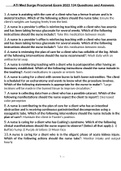Summary
Topic 1 revision summary notes A*/9 (A Level Biology Edexcel B)
- Institution
- PEARSON (PEARSON)
This document contains in-depth revision notes for topic 1 - biological molecules for the higher grades. These revision notes achieved a 9 (A**) grade. It contains diagrams and tables as needed and in-depth descriptions and definitions.
[Show more]












